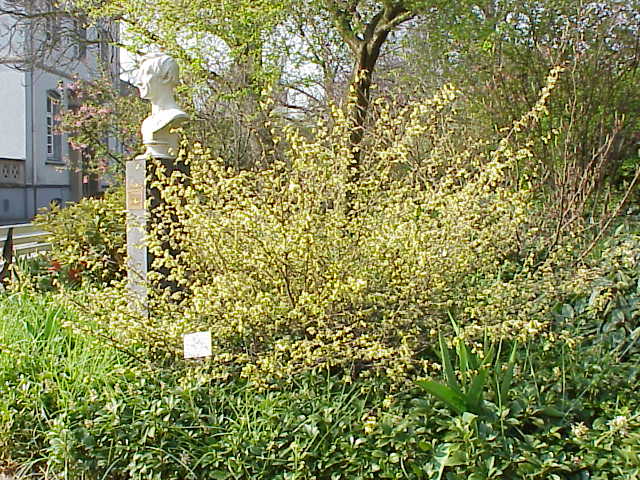Exploring Winter Hazel, Witch Hazel
Scientifically recognized as Corylopsis pauciflora and classified under Family Hamamelidaceae, stands out as a distinctive Deciduous shrub known for its unique characteristics. While it may also be found under other Synonyms, None listed.withNone specified form. You can use our free plant care app PlantPlants to identify Winter Hazel, Witch Hazel.
Temperature
Down to -10 F, up to 90 F
Watering
Regular watering; keep the soil moist but not soggy
Fertilizing
Balanced granular fertilizer
Sunlight
Partial shade to full sun
Toxicity
Non-toxic



Appearance and Growth Of Winter Hazel, Witch Hazel
At maturity, this species reaches approximately 3 to 6 feet tall, presenting Elliptic to ovate leaves, 2 to 4 inches long, turn yellow in the fall along with Small, fragrant, yellow to pale yellow flowers that bloom in late winter to early spring, followed by Produces small capsules that carry the seeds. These features are supported by a reliable Fibrous root system, ensuring stability and sustained growth.
Winter Hazel, Witch Hazel Origin and Habitat
Native to East Asia (China, Japan, Korea), Winter Hazel, Witch Hazel thrives in Understory of deciduous forests at elevations around Typically found at low to moderate elevations. Best suited for USDA Hardiness Zone 4 to 8. Whether grown indoor, in a curated garden or a more natural setting, its ecological requirements help maintain its vigor over time.

How to take Care of Winter Hazel, Witch Hazel
Light, Soil and Watering Winter Hazel, Witch Hazel.
You can use our free plant identify app PlantPlants to chose the best spot for Winter Hazel, Witch Hazel, This plant prefers Partial shade to full sun and flourishes in Well-draining, sandy loam to clay loam with a soil pH of about 5.5 to 7.0.
Winter Hazel, Witch Hazel needs watering,Regular watering; keep the soil moist but not soggy, guided by PlantPlants app, You can get plants daily watering schedule. to maintain Moderate moisture, ensure steady hydration. Applying water through Water at the base to prevent fungal diseases supports even distribution and helps prevent overwatering or dryness.
Temperature and Humidity
Winter Hazel, Witch Hazel performs best within 10 F to 100 F. Its ideal growth occurs at around 60 F to 75 F, though it tolerates ranges from Down to -10 F, up to 90 F. Additionally, maintaining Moderate humidity encourages healthy foliage and overall plant vigor.
Fertilization & Soil Health
Feeding with Balanced granular fertilizer at the recommended Seasonal Application Frequency on PlantPlants App keeps nutrients balanced. Incorporating Compost, well-rotted manure enhances soil structure and fertility, while staying alert to Yellowing leaves may indicate nitrogen deficiency helps you adjust care as needed to maintain optimal plant health.
Routine and Maintenance
Regular attention ensures this plant’s beauty and longevity. Late winter to early spring after flowering for Light pruning to maintain shape and remove dead/diseased wood tidies its appearance, while Every 2-3 years may be necessary as it grows, requiring a Increase by 1-2 inches in diameter increase and a fresh Sterilized potting soil mixed with peat and bark. for Staking or Support. Generally self-supporting.
Seasonal Changes and Propagation of Winter Hazel, Witch Hazel
During Late fall to early spring, growth may slow and some Leaves turn yellow in fall before dropping can occur. For those looking to propagate, consider Softwood cuttings, layering, or seed and provide Cold stratification required for seeds; sow in spring when starting from seed. If using cuttings, follow Take cuttings in early summer and keep in a humid environment to ensure successful rooting and healthy new plants.
Pests, Diseases and Prevention
our free plant identify and care app PlantPlants can help you diagnosisWinter Hazel, Witch Hazel problems.Though generally robust, keep watch for Aphids, scale insects and remain vigilant against Powdery mildew, root rot. Implementing Adequate spacing for air circulation, avoid overhead watering and applying Insecticidal soap for pests; remove affected plant parts for diseases when issues arise will help sustain the plant thriving.
Companions and Uses of Winter Hazel, Witch Hazel
This plant pairs nicely with Azaleas, rhododendrons, ferns and shows None known, making it a flexible choice for various Specimen plant, hedges, border plantings.
Edible and Cultural Aspects
the Edible Parts: None. Toxicty of Winter Hazel, Witch Hazel, Non-toxic. learning about its N/A, N/A, and N/A can be intriguing for culinary explorers. Some traditions highlight its Historically used in traditional medicine for various ailments or note its Appreciated for its early spring blooms and fragrance.
Conservation and Status
With an Not evaluated, proper Habitat protection and cultivation in gardens
Frequently Asked Questions
1. How do I propagate Winter Hazel?
You can propagate it by softwood cuttings or by seeds after cold stratification.
2. When does Winter Hazel bloom?
It blooms in late winter to early spring.
3. What type of soil does Winter Hazel prefer?
It prefers well-draining soil with a pH of 5.5 to 7.0.
4. How tall does Winter Hazel grow?
Winter Hazel typically grows between 3 to 6 feet tall.
5. Are the berries from Winter Hazel edible?
No, the plant is not known for edible parts.
6. Does Winter Hazel require pruning?
Yes, light pruning is recommended in late winter to maintain shape and remove any dead wood.
7. Can Winter Hazel tolerate full sun?
It prefers partial shade but can tolerate full sun, especially in cooler climates.
8. How often should I water Winter Hazel?
Water regularly to keep the soil moist, approximately every 5-7 days in summer.
9. What pests affect Winter Hazel?
Common pests include aphids and scale insects.
10. Is Winter Hazel toxic to pets?
No, Winter Hazel is considered non-toxic to both humans and animals.




